Our vanlife lifestyle is continuing to be a wonderful experience with so many plusses – we’re seeing places we’ve only dreamed of, there are new adventures almost every day, if we don’t like our surroundings, we just drive somewhere else – we’re living much more simply and spending less money. But it doesn’t come without its challenges.
We’ve come to realize the value of many needs that we once took for granted and we’ve learned that sometimes we have to go out of our comfort zone to get those needs met. We’ve put together a list of things that we feel are not only essential, but are also, sometimes difficult to find and we’re sharing the solutions we’ve used to overcome that difficulty.
But first, what are essentials? The dictionary defines essential as “absolutely necessary”. Our definition is “things we can’t live without”. And most of these are things we use everyday:
(This post contains affiliate links. We may earn compensation when you click on the links at no additional cost to you.)
1. Water
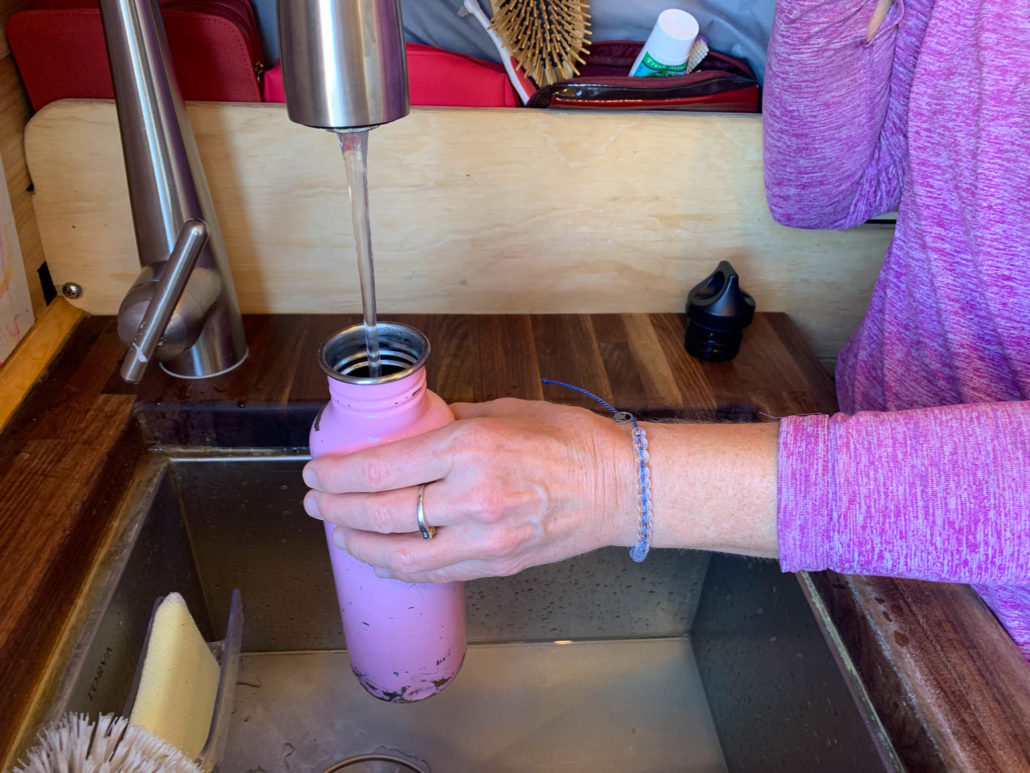
It is “the elixir of life” and one of our basic needs. We have a 22-gallon water tank in our “garage” that supplies our drinking and general use water. We also keep a full 5 -gallon jug of water under the sink for those “just in case your plumbing breaks or your water pump dies” emergencies (enough said). Refilling becomes a priority about every 3-4 days, depending on how much we use, and sometimes finding a water source is a challenge.

RV parks usually guarantee plenty of water but since we’ve started boondocking (dry camping) more we’ve had to figure out other ways of refilling.
- One of our solutions is iOverlander. It’s a smartphone app that identifies (among other things) where to find water.
- We’ve also seen businesses with water hoses outside and asked if we could fill up with limited success. Gas stations sometimes have potable water right there by the pumps.
- Once we stopped by a community garden and they let us use their hose.
- Another time we were driving through a small town in Montana and an elderly gentleman was putting away his garden hose in his front yard. We stopped and asked if we could buy some water from him and he said “oh no, just fill it up”. He was so nice and seemed to enjoy the diversion we offered him from his day as we chatted while we filled up.
- And sometimes you just happen upon some fresh running water along the side of the road. Who knew?
Bottom line: Don’t be afraid to talk to people, and get the iOverlander app.
Pro Tip: Before hooking up your water hose or filling your jugs, run the water for a few seconds to blow out any dirt or insects that might have crawled up into the spigot.
Also, keep a small clear container that you can fill first, just to get a good look at the water and give it a sniff test. Know what you’re putting in your tank! We’ve twice ended up with bad water.
2. Finding a Place to Stay

It can be pretty unnerving not knowing where you are going to stay as it’s getting dark. Or showing up to an unfamiliar place after dark and getting stuck, or finding yourself in someone else’s campsite. (Yeah, we’ve done that – Whoops! Sorry guys!)
So we have a few tricks that help us out when trying to find a place to stay:
- Smartphone apps and travel websites are a huge help with this. Some of our favorite free ones are Campendium, iOverlander again, Freecampsites.net and Sēkr (formerly The Van Life App). And sometimes it’s good to have lots in your arsenal so we also have the AllStays app which ranges in price from $1.99 to $9.99 depending on what all you want included. These have been indispensable. Many times we’ve come up empty on one only to find a great place on another. (You can also get the HipCamp, The Dyrt and FreeRoam apps as well but we don’t have enough experience with these to review them).
 And then there are membership sites. One of our favorites is Harvest Hosts. (Note: if you use this link to join, you will save 15% and we will earn a small commission). It’s a really fun way to experience wineries, breweries, museums, farms and golf courses and get a free overnight spot as well. Harvest Hosts requires an annual membership fee but then staying with your host is free, they suggest at least $20 towards supporting their business. Another good one is Boondockers Welcome. It too has an annual fee but then it introduces you to like minded people who offer their property for a place to stay for FREE. It’s truly a win-win. Both of these are really cool because they offer a more intimate experience – meeting local people who can give you an authentic experience in the various places you stay, rather than the antiseptic, filtered experience of an RV park or campground.
And then there are membership sites. One of our favorites is Harvest Hosts. (Note: if you use this link to join, you will save 15% and we will earn a small commission). It’s a really fun way to experience wineries, breweries, museums, farms and golf courses and get a free overnight spot as well. Harvest Hosts requires an annual membership fee but then staying with your host is free, they suggest at least $20 towards supporting their business. Another good one is Boondockers Welcome. It too has an annual fee but then it introduces you to like minded people who offer their property for a place to stay for FREE. It’s truly a win-win. Both of these are really cool because they offer a more intimate experience – meeting local people who can give you an authentic experience in the various places you stay, rather than the antiseptic, filtered experience of an RV park or campground.- One of our favorite experiences was finding a local resident to stay with for my 13-week nursing assignment in Iowa City. There were very few RV parks to choose from and none had availability. We ended up at a city campground for only a few days before it closed related to Covid. We did find an RV park but it was 20 miles away and I really wanted to be able to ride my bike to work. We placed an ad on Craig’s List but that became a dead end. Time was getting short with my job about to start and we were getting desperate. So Tim got on Airbnb to ask hosts if anyone had a space we could rent. One of them re-routed our message to a Facebook group for people coping with the Pandemic and in less than 30 minutes we hooked up with a woman who let us park in her driveway, hookup our electric and have access to her basement which had a shower, and laundry. Dream come true! Plus, it was only 6 miles on a nearby bike path to the University of Iowa where I was working which to this day has been the best gig so far. (And BONUS – we made life long friends in the process!)
- Staying in RV parks or campgrounds are obvious options but they cost money, so we also use Walmart and Cracker Barrel parking lots for free (be sure to check with them to make sure it’s allowed).
- Sometimes you just gotta stealth-camp on a city street. We’ve done this a number of times and so far have had no trouble. Just make sure it looks safe. Couples walking their dogs and young women jogging alone are reasonably good indicators of a safe neighborhood.
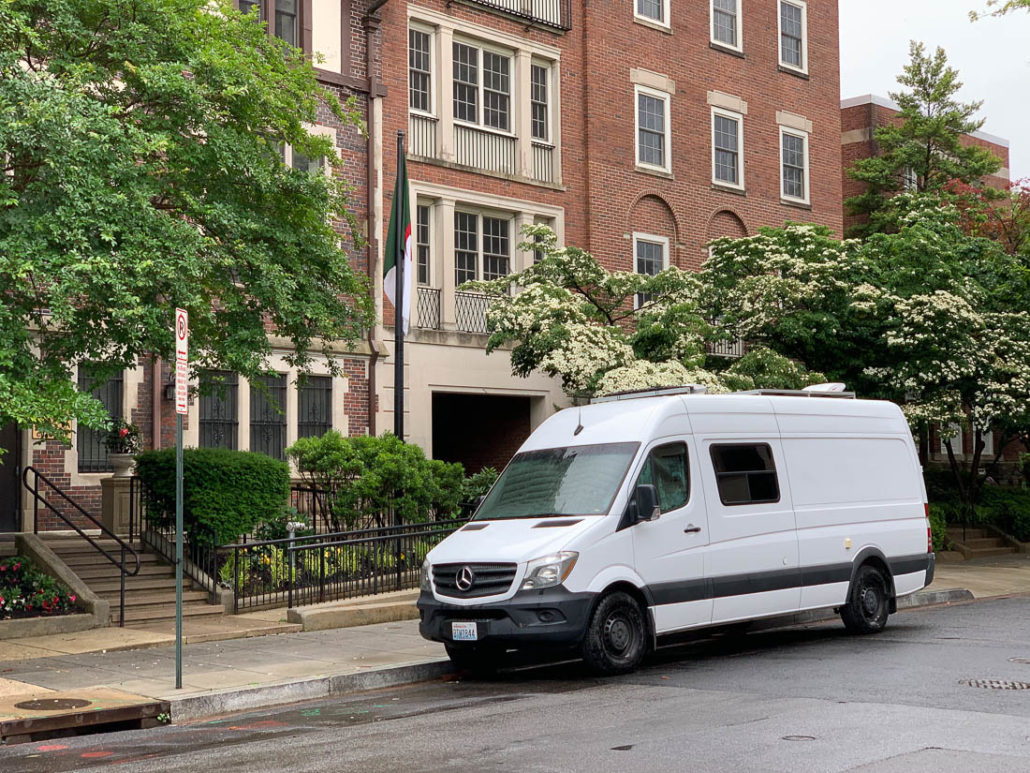
Pro Tip: Try to travel early enough so you can arrive during daylight and scout an area before committing to stay. We sometimes don’t like what we find, so it’s good to have nearby backups. (this is more difficult in the shorter winter days so be aware of when the sun sets where you’re traveling).
3. Public Shower Locations

With no shower in our van, finding public-accessible showers has become an essential task. Our least expensive and easiest option is a washcloth and water otherwise known as a “sponge bath”. Our most expensive option (but sometimes so worth it) is a paid shower at a truck stop like Love’s or Pilot. After paying $12 each one time for a shower, we figured out we could pay $12 once and take a shower together, (ooh la la!) They provide you with towels, washcloths and liquid soap if you want it. The shower rooms are clean and each has a sink and a toilet. Luxurious! Best part is I don’t have to clean it.
RV parks usually have showers so that’s a given. But you can’t always count on the condition of them. Some require that you pay for them like $2 for 6 minutes, etc. We’ve also found places to shower on the iOverlander app. Once we went to a nearby Texas State Park and just paid $3/each for entrance to the park (we were on our bicycles so it was cheap entrance fee) and got nice hot showers.
Showering is heavenly and such a mood booster (especially after several days without).
Pro tip: Don’t forget some kind of waterproof foot protection so you don’t get foot fungus (athlete’s foot). We each have designated flip-flops that we only wear for showering.
4. Dumping

Our dumping requirement is unique from most RV’s in that we have four 1-gallon jugs for urine and a 5-gallon jug for grey water under the sink. (Solid waste is mixed with soft pine pet bedding in a reused plastic grocery bag, and it’s relatively easy to find a garbage can for that). The urine jugs require dumping every other day or so. Gray water also needs dumping daily or every other day depending on how much dishwashing we have done.
Our favorite place to dump the liquids is a vault toilet like you’d find at a trailhead parking lot. Next is a public bathroom with easy access directly from the outside (like a gas station where you ask the cashier for the key and then go around to the side of the building). Interstate rest areas work well too.
This essential is still a work in progress for us because we’ve not found a reliable source for finding these favorites. If we’re in an area with lots of public outdoor activities (with the requisite public bathrooms), then we’re good.
If not, we use the apps iOverlander and Campendium or the website RVdumpsites.net and they will show us dump spots nearby but these typical RV dump sites are not as easy for us to use because we’re not using a hose and the self-closing cap gets in the way of us trying to pour from our jugs.
5. Laundry
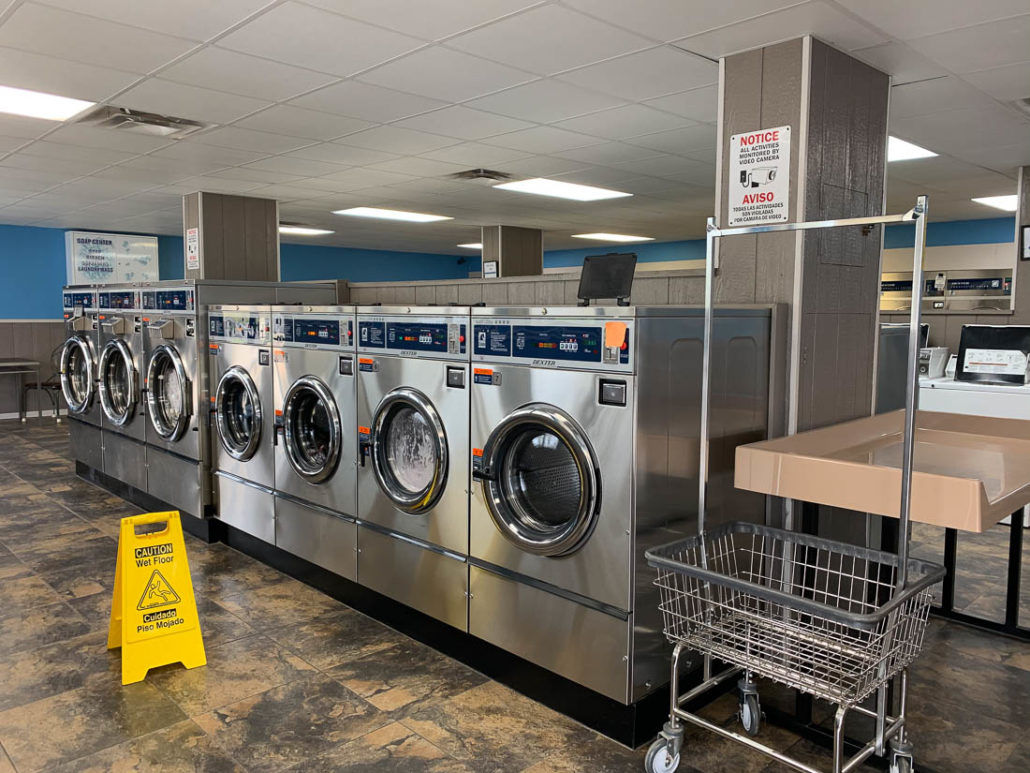
Maintaining a fresh, clean wardrobe can be difficult when you’re constantly on the move. Mostly we use the Google Maps app to find laundromats when we are in new surroundings although some of the other apps we’ve already mentioned show laundry facilities as well.
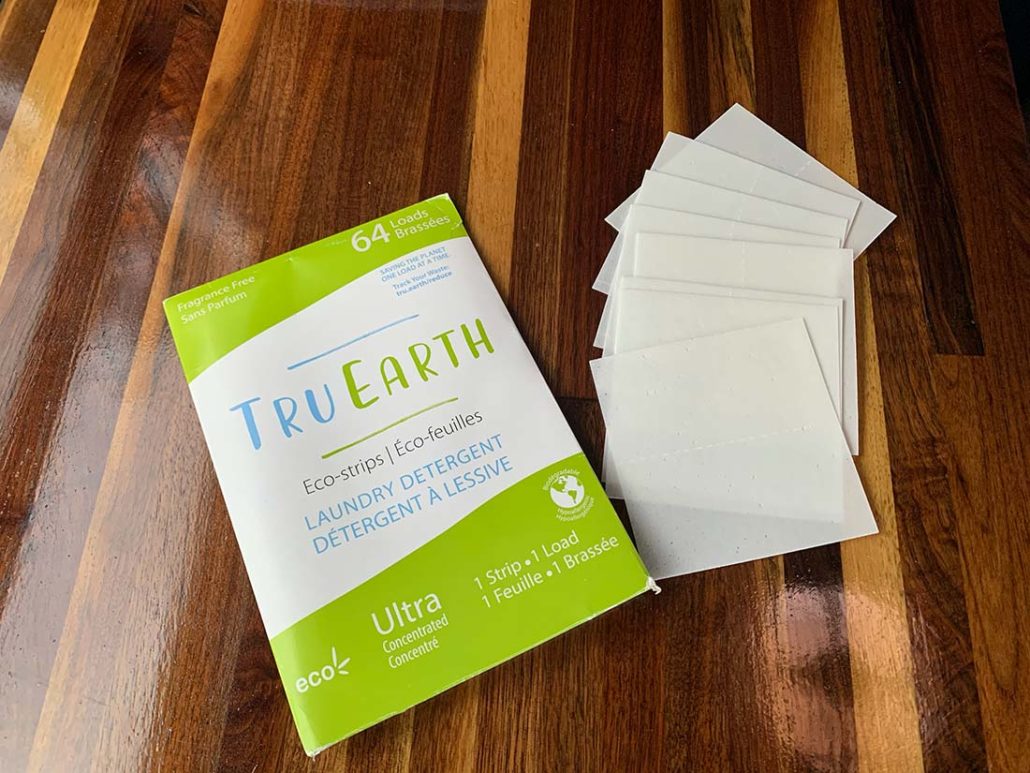 But one very important thing to mention, considering the lack of storage space we have with this lifestyle is TruEarth detergent. It’s a dry flat square of laundry detergent. It eliminates the big bulky plastic jugs of laundry detergent that would take up space. This is the size of a file folder for 64 loads worth of laundry. It’s a great product for a great price.
But one very important thing to mention, considering the lack of storage space we have with this lifestyle is TruEarth detergent. It’s a dry flat square of laundry detergent. It eliminates the big bulky plastic jugs of laundry detergent that would take up space. This is the size of a file folder for 64 loads worth of laundry. It’s a great product for a great price.
Also – don’t forget quarters! Most places have a change machine but be prepared – I got stuck one time not having enough quarters to dry. It was a weekend so the banks were closed, the grocery down the street wouldn’t exchange for quarters and the Laundromat change machine was “Out of Order”. Luckily it was warm out and we just draped our clothes outside on rocks and let them dry. Unfortunately that doesn’t work as well in 88% humidity (or rain). We’ve added a clothesline to our overhead cabinets for things that need line drying.
6. Smart Phone Mapping App

OK, so these wonderful apps we’ve mentioned show you where all the cool places are, but how do you get there? Well there’s an app for that as well – actually quite a few.
We prefer the Google Maps app and we use it daily for many different things. One of the good things about it is, if you have a Google account (which you do if you use Gmail or have a YouTube account, or a Google Docs account among many other things…) you can use the save locations feature. This is extremely useful if you’re in unfamiliar territory and you need to go several places. Maybe you need to go to a grocery store, a laundromat, and find a place to dump and you don’t want to be backtracking. You can save all three locations to a “Want to go” list and then zoom out a bit and see where they all are in relation to one another and your ultimate destination, and then figure out the best route to get to them all.
Once you have your destination plugged in, you can tap on “Directions” and it will show you several routes to get there from either your current location or a different location you choose. Plus it will show you estimated driving time. (or walking time, or biking time). You can also choose to avoid highways, avoid tolls, etc. if you want. Tap on “Start” and the lovely Google voice will give you real time, step-by-step driving directions.
Other apps are Apple’s Maps, and Waze but we don’t have as much experience with them.
7. The Right Attitude

This essential is so simple but so important. It makes all the difference in the world if you love what you are doing and who you are doing it with. And sometimes it helps to stop, take a big deep breath and start again if things aren’t going the way you’d hoped.
It’s best if you can be ready for letdowns. Finally arriving at your overnight spot just before sundown, the one that got so many good reviews, only to find that it’s gone downhill. That it’s overcrowded or that there’s no availability for you. Maybe there are full-timers living there now who don’t appear to have paid their garbage bill.
So now you need to keep driving on to another one.
This. Will. Happen.
And it is part of the adventure. Be ready for it and don’t let it own you. As said above, have a nearby backup plan whenever possible.
Some things that can help you maintain a positive attitude:
- Make sure you’re getting enough sleep
- Eat a balanced diet
- Be sure to exercise regularly
- Even if you love the one you’re with to pieces, make sure to get some alone time to take care of yourself
A positive attitude gives you power over your circumstances instead of your circumstances having power over you –Joyce Meyer
8. America the Beautiful Pass – Is it worth it?
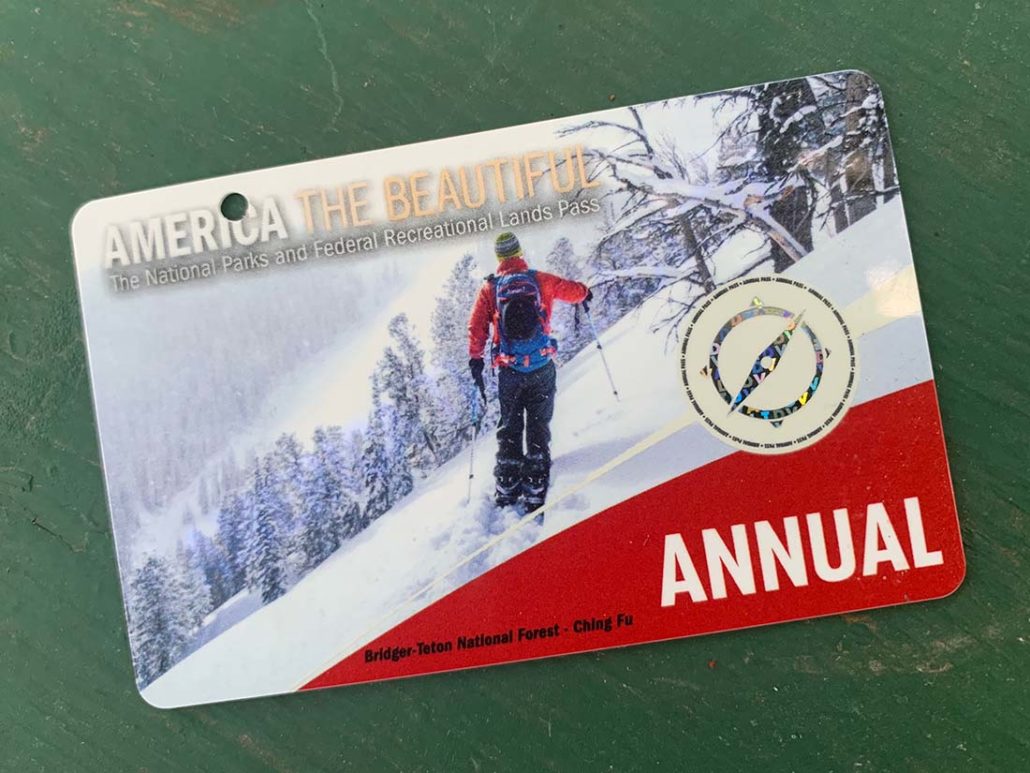
For $80.00 it covers all passengers in a personal vehicle and is valid for one year from the date it was purchased. The America the Beautiful Pass is your ticket to more than 2,000 federal recreation sites. Each pass covers entrance fees, standard amenity fees and day use fees at national parks, national monuments, national wildlife refuges and national forests.
Most of the National Parks are in the western states so this makes the pass of particular value out there. Because these parks would otherwise cost $30 for one car for one day, and because we’ve gotten discounts in camping areas as well, we think this pass is well worth it.
9. Bring Your Checkbook
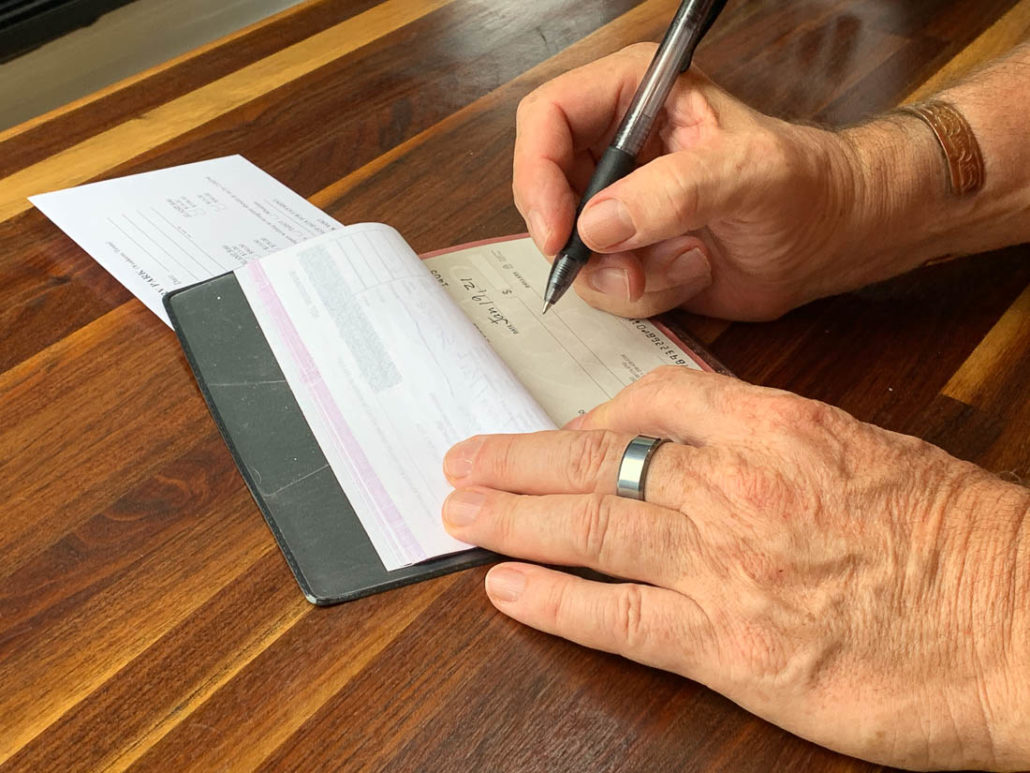
We like to use checks when staying at a self-pay campground or park. It’s a lot harder for thieves to use a stolen check number than a stolen credit card number.
We did pay once by writing our credit card number on a registration card, only to find out the next morning that the fee kiosk was vandalized. Luckily the park ranger let us know so we could cancel our credit card. (But what a pain that was, and on the first night of a 3-week trip too.)
You can pay with cash, but then there’s no record of your payment if that becomes an issue. Also, when you pay with a check, if there is ever a dispute about services promised and not delivered, you can always stop payment on your check.
10. Tools
 You should always have a few tools with you for minor repairs. The age and condition of your vehicle will really help determine extent of your tool collection but at the very least, you should have:
You should always have a few tools with you for minor repairs. The age and condition of your vehicle will really help determine extent of your tool collection but at the very least, you should have:
- A few screwdrivers (or a 6-in-1 screwdriver)
- An adjustable wrench
- Some pliers
- Wire cutters
- Electrical tape
- Duct tape
- WD-40
- Cable ties
- Spare fuses
- All-purpose glue
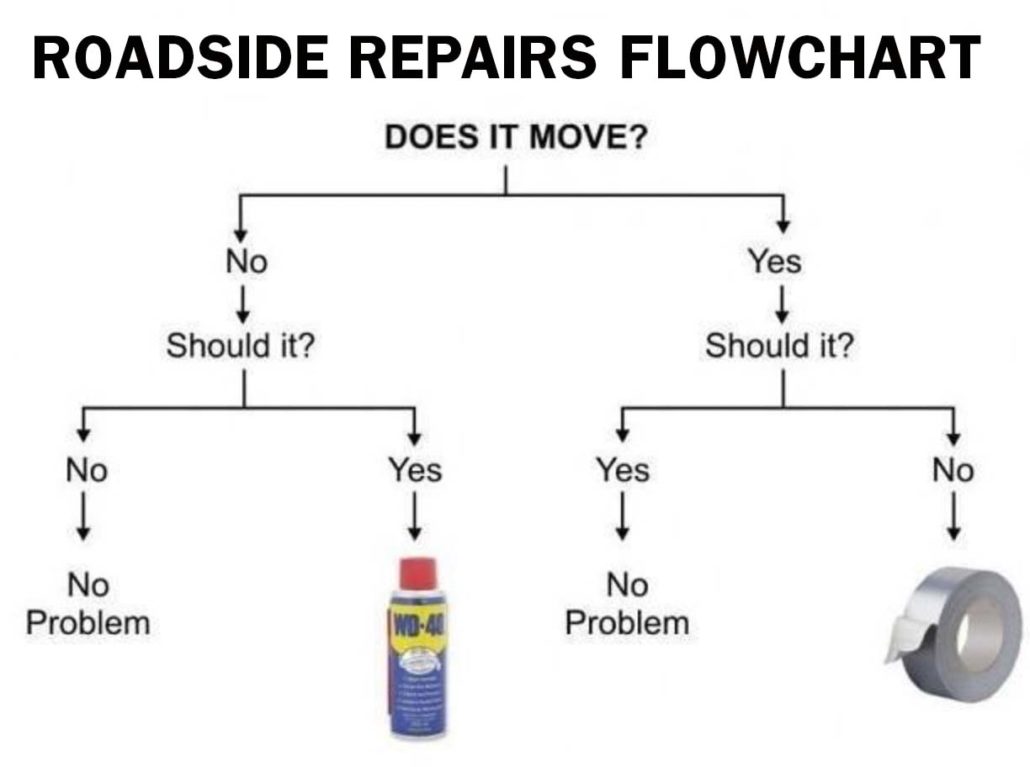
When we hit the road our van was not complete yet and we knew we still had more building to do, so we kinda went overboard but it is so nice to have all those tools with us for just in case (a lot more than you see in this photo).
Also, one totally unexpected item that got us out of a jam was our bicycle pump. We were on a northern California coastal highway and we got a flat tire. The lug nuts were torqued on so tight we could not remove the wheel to swap it out with our spare. We had no cell signal whatsoever, and there was not much traffic at all. So – we used the bicycle pump! It took almost 30 minutes taking turns of hard pumping, but we finally had enough air in the tire that we could drive to the nearest town about 10 miles away and get our flat fixed. (and how lucky we were that tire held the air long enough!)
If you don’t have any tools, pick some up before you head out on the road. Even the most basic tool set will make your life a lot easier if problems arise in the middle of nowhere.
* * * * * * *
We hope this list is useful for you, especially if you’re just starting out on your journey and, like us, have a million questions. There are many other things that could have made this list as well, but we pared it down to what we use most often. If you have questions or comments, please hit us up in the comments section below or send us an email. We’d love to be able to help out if we can.

5 thoughts on “10 Essentials of Van Life”
Thank you. This is a great list. Very helpful
Polly 2015 Pleasureway Ascent
Oh I’m so glad it was helpful!! Safe Travels.
We enjoyed and will use some of your great travel tips and sites. Thanks for sharing! Tom and Robin
Awesome list you guys. Dan and I pick up our trailer in September. We don’t plan on living it but there are some great tips for when we drove it back from Minnesota.
Glad you guys like it Carla and congrats on the new rig! We’ll have to do a camp meetup with you somewhere!